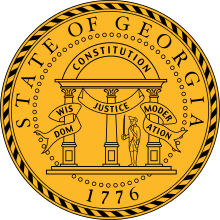Eurith D. Rivers
| Eurith D. Rivers | |
|---|---|
 | |
| Rivers visiting the White House as the Georgian governor-elect on December 22, 1936. | |
| 56th Governor of Georgia | |
| In office January 12, 1937 – January 14, 1941 | |
| Preceded by | Eugene Talmadge |
| Succeeded by | Eugene Talmadge |
| Speaker of the Georgia House of Representatives | |
| In office 1933–1937 | |
| Personal details | |
| Born | Eurith Dickinson Rivers December 1, 1895 Center Point, Arkansas, U.S. |
| Died | June 11, 1967 (aged 71) Lakeland, Georgia, U.S. |
| Nationality | American |
| Political party | Democratic |
Eurith Dickinson "Ed" Rivers (December 1, 1895 – June 11, 1967) was an American politician from Lanier County, Georgia. A Democrat, he was the 56th Governor of Georgia from 1937 to 1941.
Early life and education
Eurith Dickinson Rivers was born on December 1, 1895 in Center Point, Arkansas. He attended Young Harris College, and settled in Cairo. Rivers also obtained a law degree through La Salle Extension University.[1] A Democrat, Rivers served as a Justice of the Peace, Cairo City Attorney, and Grady County Attorney. He later moved to Milltown (now called Lakeland) to became editor of the Lanier County News.
Career
Rivers was elected to the Georgia House of Representatives in 1924 and to the Georgia State Senate in 1926. In 1928 and 1930 Rivers was an unsuccessful candidate for the Democratic nomination for Governor. In 1932 he ran for the Georgia House of Representatives. He was elected Speaker, serving from 1933 to 1937.
His election as governor came after a stormy Democratic primary in 1936 in which the race served as a surrogate referendum on President Franklin D. Roosevelt's New Deal. Since Georgia didn't allow three consecutive terms, Governor Eugene Talmadge was not eligible for re-election. Talmadge, who strongly opposed the New Deal and had delayed its implementation in Georgia, ran for the U.S. Senate and backed Charles D. Redwine for governor. Rivers, who as Speaker of the Georgia House of Representatives had strongly supported the New Deal, was his opponent, and won with about 60 percent of the vote (the same margin by which Talmadge lost his Senate race).
Rivers' first two-year term as governor saw Georgia pass the legislation required to bring New Deal programs into the state, and was widely acclaimed. Rivers created the 7 month school year. Under Rivers' leadership, electrical services were expanded to rural areas of the state. Georgia moved from the lowest-ranked state to the top of the list in the number of rural electrification associations. When he was in office, the State Bureau of Unemployment Compensation was created, allowing Georgians to receive unemployment benefits.
After Rivers' re-election in 1938, he ran into problems financing many of his improvement programs. Although the budget was reduced by 25 percent, he was able to convince the legislature to create the Georgia Housing Authority and obtain federal funds to build public housing. During Rivers' second term, there were political scandals and charges of corruption. Many of Rivers' appointees and staff members were charged with corrupt practices, and the charges reflected poorly on the governor.
In 1939, Rivers proclaimed a state holiday for the December premiere of the film Gone With the Wind.
Later life and death
Rivers died at Lakeland, Georgia in 1967 and is buried in the City Cemetery there.
See also
References
- ↑ Georgia Dept. of Archives and History (1925). Georgia's official register. Longino and Porter
External links
| Wikiquote has quotations related to: Georgia (U.S. state) |
| Political offices | ||
|---|---|---|
| Preceded by Eugene Talmadge |
Governor of the State of Georgia January 12, 1937 – January 14, 1941 |
Succeeded by Eugene Talmadge |
| ||||||||||||||||
|
